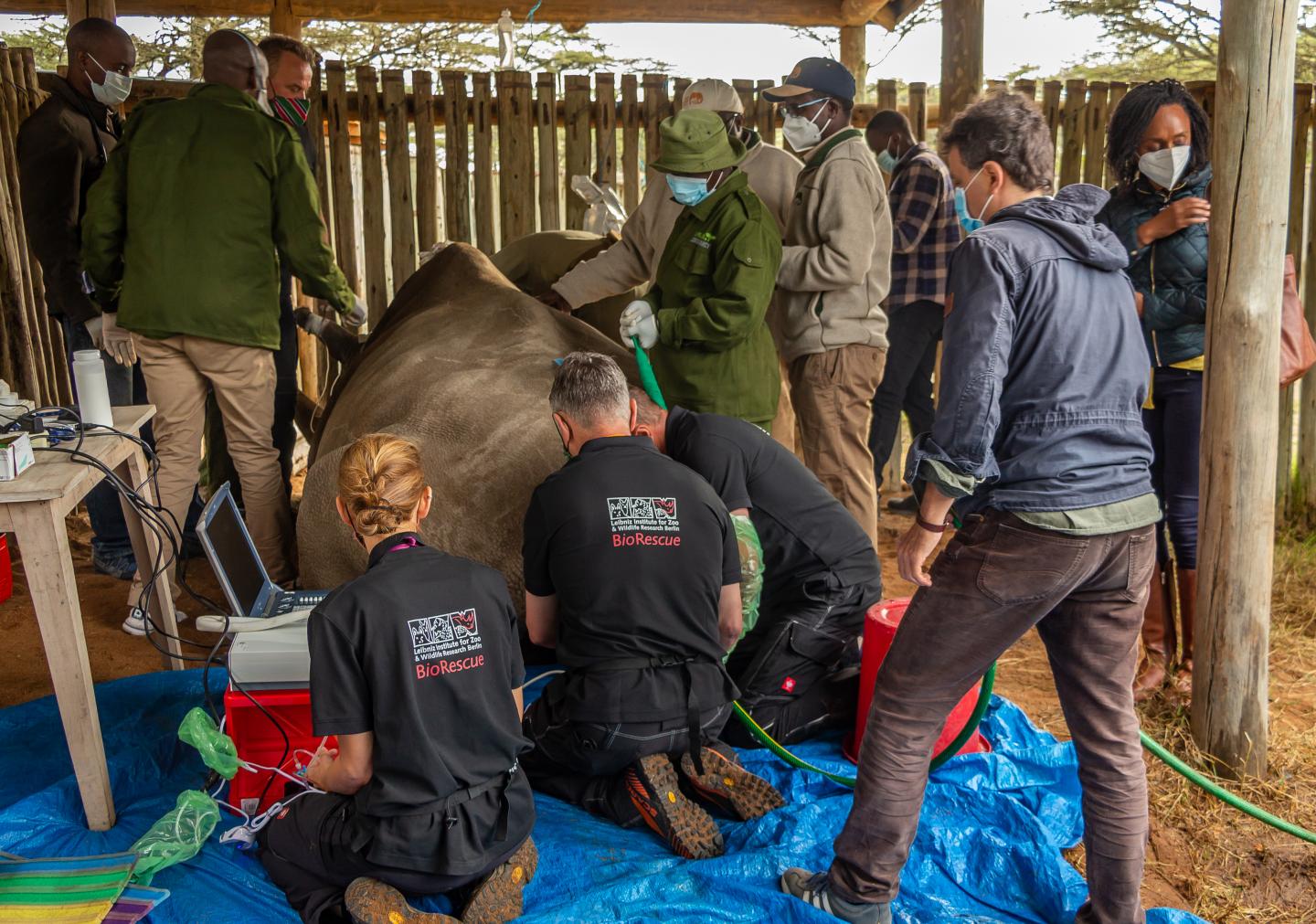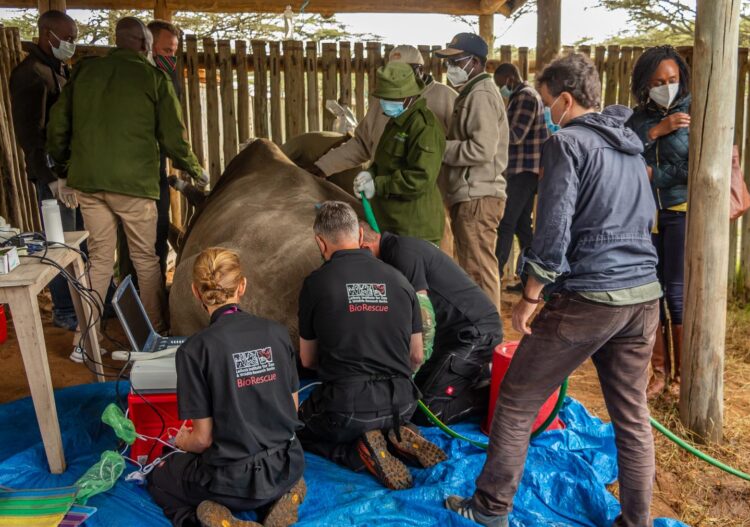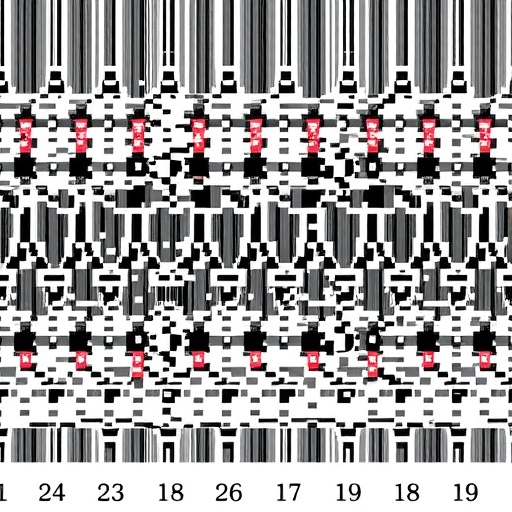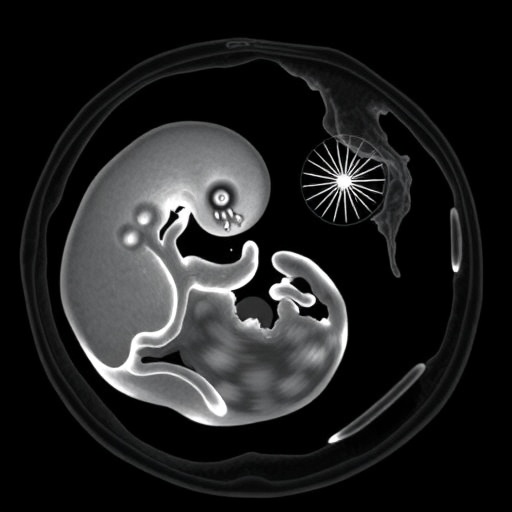
Credit: Rio/Ol Pejeta Conservancy/BioRescue
After a hiatus of a few months owing to the global COVID-19 pandemic, the international team of scientists and conservationists continued its ambitious programme to save the northern white rhino from extinction: On August 18, 2020 they harvested ten eggs from the last remaining two individuals, Najin and Fatu, in the third-ever ovum pickup procedure in northern white rhinos, at Ol Pejeta Conservancy in Kenya. With great support from the Kenya Wildlife Service and the Kenyan Ministry of Tourism and Wildlife, the team from the German Leibniz Institute for Zoo & Wildlife Research (Leibniz-IZW) and Czech Safari Park Dvur Králové overcame substantial challenges to perform this important procedure in such critical times. Preparations for the next steps in the programme – the generation and transfer of embryos – are underway, ensuring that everything is done to make the best possible progress to save the northern white rhino from the brink of extinction.
“The progress made so far in the northern white rhino assisted reproduction project is very encouraging, and we look forward to the transfer of the already developed embryos into southern white rhino surrogate females here at Ol Pejeta Conservancy. This project should galvanise the world’s attention to the plight of endangered species and make us avoid actions that undermine law enforcement and fuel demand for the rhino horn,” says Hon. Najib Balala, Kenya’s Cabinet Secretary for Tourism and Wildlife.
Germany’s Federal Research Minister Anja Karliczek: “Biodiversity forms the foundation of our very existence. But it is increasingly threatened by the destruction of natural habitats, environmental pollution and climate change. The northern white rhinoceros has become a symbol for our joint efforts to fight the loss of biological diversity. The Federal Ministry of Education and Research supports this rhino conservation work through the funding it provides for the BioRescue project, which is part of the Research Initiative for the Conservation of Biodiversity. We are extremely grateful for the support we have received from the Kenyan government as partners in our efforts to save the northern white rhino. Thanks to the tremendous commitment shown by all involved, we now have the chance to save this animal from the threat of extinction.”
Twelve months after the ground breaking first “ovum pickup” in August 2019 and eight months after the second, the team repeated the procedure with northern white rhinos Najin and Fatu on August 18, 2020, at Ol Pejeta Conservancy in Kenya. The animals were placed under general anaesthetic and ten immature egg cells (oocytes) – two from Najin and eight from Fatu – were harvested from the ovaries using a probe with a movable needle guided by ultrasound. The anaesthesia and the ovum pickup went smoothly and without any complications. The oocytes were airlifted immediately to the Avantea Laboratory in Italy. In the coming days they will be incubated and matured and fertilised with sperm from already deceased northern white rhino bulls – hopefully leading to viable northern white rhino embryos that will be stored in liquid nitrogen alongside the three embryos generated during the previous procedures.
This procedure was conducted several months behind the original schedule of BioRescue, the international consortium led by the Leibniz-IZW and partially funded by the German Federal Ministry of Education and Research. The COVID-19 pandemic has severely affected the project and its partners: travel restrictions and contact prohibitions prevented work from taking place in European zoos and Ol Pejeta Conservancy. Partner organisations such as Safari Park Dv?r Králové and Ol Pejeta Conservancy faced – and continue to face – an existential threat as they largely depend on tourism. In several ways, the current COVID-19 pandemic poses an unprecedented threat to wildlife conservation. It is the hope and the will of all partners of the northern white rhino rescue programme to continue its mission against the odds. Since the northern white rhino offspring that will hopefully arise from the programme shall grow up in the company of Najin and Fatu and Najin is approaching old age, there is no time to lose.
Preparations for the next steps of the mission are underway. The plan is to select a group of southern white rhinos at Ol Pejeta Conservancy from which a female would be selected to serve as surrogate mother for the northern white rhino embryo. Additionally, the partners agreed on the procedure of sterilising a southern white rhino bull. This bull, which has already produced many offspring, is crucial to indicate oestrus and to create an ideal hormonal environment in the potential surrogates. To achieve the best possible results for work with pure northern white rhino embryos, the team relies on experience from similar embryo transfer procedures in southern white rhinos that have been performed in order to address reproduction challenges in European zoos.
QUOTES
Thomas Hildebrandt, Head of BioRescue project, Head of Dept Reproduction Management, Leibniz-IZW
“As scientists we are used to fundamental challenges and to finding entirely new approaches to problems. Pushing boundaries is essentially what we are trying to achieve with the advanced assisted reproduction technologies and stem cell associated techniques in BioRescue. Still, we were hit hard by the impact of the corona virus pandemic and had to clear many obstacles to resume our work. On the other hand, this time of crisis shows the importance of our mission: We always regarded BioRescue as not only focused on creating new offspring of one single species, but rather as a first milestone in repairing severely disturbed habitats in Central Africa. Re-introducing a giant grazer back into these habitats will help rebuilding the natural resilience of these ecosystems and significantly decrease the risk of new pandemics.”
Cesare Galli, Director of Avantea
“It is important that we do not lose the momentum initiated in August last year with the production of the first embryos. Such complex procedures require continuous practice to be successful at all levels from oocyte collection to fertilisation embryo culture and freezing. It is a great news that the work has resumed. Time works against us as the oocytes that are not harvested will be lost physiologically anyway so we must try to do as many collections as possible in absolute safety and we know that we can achieve that with the high skilled team working in BioRescue. But collecting oocytes in Ol Pejeta is only the tip of the iceberg. A lot of work is taking place behind the scenes in European zoos to be able to establish the first pregnancy with southern white rhino embryos as this will be instrumental before we thaw and transfer any northern white rhino embryos.”
Jan Stejskal, Director of International Projects, Safari Park Dvur Králové
“It is promising that our team was able to harvest eggs today, especially from Najin. We have to be mindful that her age and general health condition might not allow us to collect eggs anymore in the future. In order to save the northern white rhinos it would be really beneficial to produce embryos from Najin, not only from Fatu as we succeeded after the previous procedures.”
Richard Vigne, Managing Director, Ol Pejeta Conservancy
“At Ol Pejeta, despite the existential threat that is posed by the ongoing COVID pandemic, we are immensely proud to be continuing our work to save endangered species. As well as supporting the work to save the northern white rhino, we are working with our partners to safeguard East Africa’s single largest population of black rhino, as well as numerous other threatened species. It is work that is becoming more and more important as the human race continues to ravage the natural world, and we very much hope that our efforts keep drawing attention to the threats posed to biodiversity across the globe.”
Brig (Rtd) John Waweru, Director General, Kenya Wildlife Service
“We are delighted that this partnership gets us one step closer to prevent extinction of a species. This is particularly touching given there is no remaining male of the species in the world”.
Barbara de Mori, Director of the Ethics Laboratory for Veterinary Medicine, Conservation and Animal Welfare – University of Padua
“As scientists we have a strong ethical responsibility to do whatever is in our possibilities to save the North White Rhino from extinction and to give a chance to Naijn and Fatu to raise their offspring. The race against time has been exacerbated by the COVID-19 pandemic and now we have to try to regain the lost time. As in previous procedures on the Northern White Rhino females a detailed ethical assessment of all major steps before, at and after the intervention were regularly performed in order to assure the welfare of the animals involved and to gain a high quality of research results. The next steps of the mission will be ethically monitored with care, the aim is to get offspring very soon.”
Sebastian Bohl, Vice President, Global Head of New Businesses, Fertility, Merck
“After eight long months, it’s fantastic to see this ambitious endeavor to save the Northern White Rhino take next steps. As we think of the challenges ahead, we feel very proud to continue to be in this together with Project BioRecue as a long-term partner, providing our technology, expertise and experience in fertility to their important work. We know any journey using assisted reproductive technologies can have ups and downs and just how important it is to give these embryos the best chance of success.”
###
ABOUT THE PARTNERS
Ministry of Tourism and Wildlife (MoTW) is responsible for overall policy direction on tourism and wildlife in Kenya. http://www.
Kenya Wildlife Service (KWS) is the principal government institution that conserves and manages wildlife for Kenyans and the world. It also enforces related laws and regulations. http://www.
German Federal Ministry for Education and Research (BMBF)
http://www.
The Leibniz Institute for Zoo & Wildlife Research (IZW) is an internationally renowned German research institute. It is part of the Forschungsverbund Berlin e.V. and a member of the Leibniz Association. Our goal is to understand the adaptability of wildlife in the context of global change and to contribute to the enhancement of the survival of viable wildlife populations. For this purpose, we investigate the diversity of life histories, the mechanisms of evolutionary adaptations and their limits, including diseases, as well as the interrelations of wildlife with their environment and people. We use expertise from biology and veterinary medicine in an interdisciplinary approach to conduct fundamental and applied research – from the molecular to the landscape level – in close dialogue with the public and stakeholders. Additionally, we are committed to unique and high-quality services for the scientific community. http://www.
Ol Pejeta Conservancy is the largest black rhino sanctuary in east Africa and is the only place in Kenya to see chimpanzees. It is also home to the last two northern white rhinos on the planet. Ol Pejeta’s cutting-edge wildlife security includes a specialised K-9-unit, motion sensor cameras along its solar-powered electric fence, and a dedicated Rhino Protection Unit. http://www.
Safari Park Dvur Králové is a safari park in the Czech Republic. It’s one of the best rhino breeders outside of Africa and the only place where the northern white rhino bred in human care – both remaining females, Najin and Fatu, were born here. Dvur Králové Zoo coordinates efforts to save the northern white rhinos. safaripark.cz/en/
Avantea is a laboratory of advanced technologies for biotechnology research and animal reproduction based in Cremona, Italy. Avantea has over twenty years of experience and the know-how in assisted reproduction of livestock developed through years of research conducted in the biomedical and animal reproduction fields. http://www.
The University of Padua in Italy is one of the oldest in the world, celebrating 800 years. Its Department of Comparative Biomedicine and Food Science is developing leading research and education in the field of wildlife conservation and welfare with a special focus on ethical assessment and evaluation of research projects and educational programs. http://www.
Merck, a leading science and technology company, operates across healthcare, life science and performance materials. Around 57,000 employees work to make a positive difference to millions of people’s lives every day by creating more joyful and sustainable ways to live. From advancing gene editing technologies and discovering unique ways to treat the most challenging diseases to enabling the intelligence of devices – the company is everywhere. In 2019, Merck generated sales of € 16.2 billion in 66 countries.
Scientific exploration and responsible entrepreneurship have been key to Merck’s technological and scientific advances. This is how Merck has thrived since its founding in 1668. The founding family remains the majority owner of the publicly listed company. Merck holds the global rights to the Merck name and brand. The only exceptions are the United States and Canada, where the business sectors of Merck operate as EMD Serono in healthcare, MilliporeSigma in life science, and EMD Performance Materials. http://www.
Media Contact
Thomas Hildebrandt
[email protected]
Original Source
https:/





